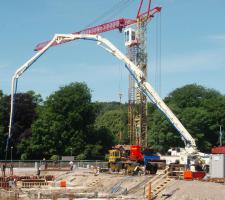
The British Concrete Pumping Interest Group (BCPIG), part of The Construction Plant-hire Association (CPA), since 1993, has been working closely with the
Concrete pumps and concrete placing booms make a significant contribution to the efficient delivery of the construction process. The development of concrete pumps has allowed concrete to be pumped under pressure through pipelines across great distances and in significant volumes. Unfortunately the very versatility that makes them so useful also provides scope for unsafe use, this has led to a significant number of serious accidents, tragically including some fatalities.
As with all construction equipment, the safe operation of concrete pumps depends on a number of factors including the selection and maintenance of the pump and placing boom, the planning and supervision of their use, and the competence of the operator and other personnel. If any of these are deficient, the risk of a serious accident increases significantly, so it is essential that site managers ensure that all concrete pumping operations are planned, supervised and carried out safely.
“This new guidance has been prepared by a Working Group representing all parts of the industry, including the Health and Safety Executive, to provide clarity on the safe use of concrete pumps, including planning, role of personnel, training and familiarisation of personnel, safe use, maintenance, inspection and thorough examination. The guidance is straightforward, comprehensive and easy to adopt. It represents good practice which may go further than the minimum you need to do in order to comply with the law,” says Heather Bryant , HM chief inspector of construction, chair of the Health and Safety Executive’s Construction Industry Advisory Committee.
The guidance also covers selection of personnel. For example, the operator must be over 18 years of age if operating a concrete pump onsite and over 18 years of age if driving a concrete pump on the highway. This is subject to meeting with certain criteria otherwise the minimum age is 21 years.
There’s a section which is specifically for the hirer and the hirer’s responsibilities in requesting a suitable concrete pump such as suitable access to and egress from the site suitable for the size of the machine and sufficient area for all the machine’s stabilisers to be fully deployed.
A page on recommended hand signals for operators has been clearly illustrated and an example of daily and weekly checks and inspections record to ensure the users concrete pump remains in tip top condition.
The Good Practice Guide for the Safe Use of Concrete Pumps can be downloaded FOC from the CPA website at www.cpa.uk.net. The guidance supersedes old code of practice which was first released in 2004.









